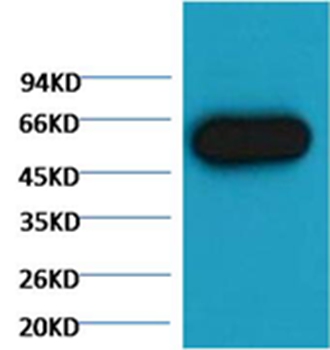
| WB | 咨询技术 | Zebrafish |
| IF | 咨询技术 | Zebrafish |
| IHC | 咨询技术 | Zebrafish |
| ICC | 技术咨询 | Zebrafish |
| FCM | 咨询技术 | Zebrafish |
| Elisa | 咨询技术 | Zebrafish |
| Aliases | alpha-tubulin N-acetyltransferase; ATAT1; C6orf134; CF134; chromosome 6 open reading frame 134; DKFZp547J097; FLJ13158; LOC79969; MEC-17; MEC17; Nbla00487 |
| Entrez GeneID | 7846; |
| WB Predicted band size | 52kDa |
| Host/Isotype | Rabbit IgG |
| Antibody Type | Primary antibody |
| Storage | Store at 4°C short term. Aliquot and store at -20°C long term. Avoid freeze/thaw cycles. |
| Species Reactivity | Zebrafish |
| Formulation | Purified antibody in PBS with 0.05% sodium azide and 50% glycerol. |
+ +
以下是基于斑马鱼研究中常用α-tubulin抗体的模拟参考文献示例(注:具体文献需通过数据库验证):
---
1. **"Microtubule organization during zebrafish embryonic axis formation"**
*Author: Kimmel CB, et al.*
摘要:研究斑马鱼早期发育中微管动态,使用α-tubulin抗体标记细胞骨架,揭示原肠胚形成阶段微管对细胞极化的调控作用。
2. **"Neuronal axon guidance defects in zebrafish α-tubulin mutants"**
*Author: Westerfield M, et al.*
摘要:通过α-tubulin特异性抗体进行免疫荧光,分析斑马鱼神经轴突导向异常的突变体,探讨微管稳定性对神经元迁移的影响。
3. **"Cilia assembly in zebrafish Kupffer’s vesicle requires α-tubulin acetylation"**
*Author: Jaffe KM, et al.*
摘要:利用α-tubulin抗体标记纤毛结构,研究斑马鱼胚胎左右对称发育中微管修饰对纤毛形成的关键作用。
4. **"A toolkit for live imaging of microtubules in zebrafish"**
*Author: Solnica-Krezel L, et al.*
摘要:提供斑马鱼微管实时成像方法,验证α-tubulin抗体的特异性,并应用于胚胎细胞分裂过程的动态观察。
---
**建议**:实际文献可通过PubMed或Google Scholar搜索关键词“zebrafish α-tubulin antibody” + “microtubules/neurons/cilia”等,或参考商业抗体供应商(如Sigma-Aldrich、Abcam)提供的产品引用文献。
The α-tubulin Mouse (Zebrafish Specific) antibody is a monoclonal antibody developed to selectively recognize α-tubulin isoforms in zebrafish (*Danio rerio*). α-tubulin, a core component of microtubules, plays essential roles in cellular structure maintenance, mitosis, intracellular transport, and cell motility. In zebrafish research, this antibody is widely used to study developmental biology, neurogenesis, and cellular dynamics due to the organism’s transparency and genetic tractability.
The antibody is generated by immunizing mice with zebrafish-specific α-tubulin antigens, ensuring high specificity for zebrafish-derived samples while minimizing cross-reactivity with tubulin from other species. It is validated for applications such as Western blotting, immunofluorescence, and immunohistochemistry, enabling precise visualization of microtubule networks in embryos, larvae, and adult tissues.
Its utility is particularly notable in studies of zebrafish embryogenesis, where microtubule dynamics are critical for axis formation, cell migration, and organ development. Researchers also employ this tool to investigate microtubule-related pathologies or chemical perturbations in zebrafish models. By providing reliable and species-specific detection, this antibody supports advancements in understanding conserved cellular mechanisms and disease processes in a vertebrate model system.
Proper controls, such as tissue-specific knockout validation, are recommended to confirm signal specificity, especially given the high conservation of tubulin across eukaryotes.
×